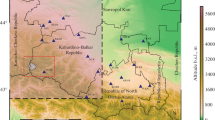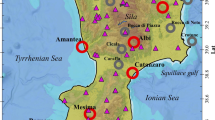Abstract
Northeastern Algeria is known by its high seismic activity as reflected by several hundreds of events occurring every year. Recently, this area has been the seat of several seismic sequences such as the 2010 Beni-Ilmane earthquake sequence and the 2012–2013 Bejaia earthquake sequences. On the other hand, it is also observed that the seismic activity of this part of Algeria is dominated by swarms, with high concentrations in time and space, from a few days to several months, ranging from a few kilometers to ten kilometers, and sometimes showing a migration of several kilometers in several weeks. The earthquake swarms are related to the increase in the water body of the reservoir after a heavy precipitation (Beni-Haroun (B-H) dam on 2012), and to the increase in the interstitial pressure due to the fluid injection (the 2007 Mila crisis and Grouz reservoir crisis) or due to the water circulation in hydrothermal systems (Ain Azel, El-Hachimia, Azzaba and Djemila swarms). Here, 10 swarms occurring in the region were analyzed using statistical laws, and finally the results have been discussed.
Access provided by Autonomous University of Puebla. Download conference paper PDF
Similar content being viewed by others
Keywords
1 Introduction
Earthquake swarms are earthquake sequences without a discernible main-shock. Swarms can last weeks and produce many thousands of earthquakes within a relatively small volume (Miller 2013). Swarms are observed in volcanic environments, hydrothermal systems, and other active geothermal areas. Also, numerous examples of the microseismic activity generated by the increase in interstitial pressure have been described in the literature and probably concern with the filling of dam reservoirs (Gupta 1983) or the injection of fluids at depth (Cornet et al. 2007). This induced seismicity is related to the increase in water in the reservoir causing the increase in the interstitial pressure due to the fluid diffusion. In contrast, earthquake swarms may confine to the fluid-filled fractured rock matrix (Kayal et al. 2002; Mishra and Zhao 2003; Mishra et al. 2008). Changes in the water pressure once exceeded the effective pore pressure at shallow layers that lead to seismogenesis in swarms. Percolation of continuous rain water during monsoon season through the active faults or cracks may also lead to genesis of earthquake swarms as observed in Talala source zone of Gujarat, India (Singh and Mishra 2015). But here we have studied the statistical behavior of earthquake swarms occurred in northeastern Algeria in between 2000 and 2018 using the Algerian catalogue, including those and some seismic events recorded by portable stations installed after the occurrence of several shocks.
We identify 10 possible swarms (Fig. 1), and we applied some statistical tests on the size of seismic events and on the time intervals between successive earthquakes, which have made it possible to identify the existence of forcing linked either to creep processes, to a fluid percolation phenomenon, or to the coupled action of these two processes.
2 Scientific Background, Data and Methodology
The seismic data were collected by the Algerian seismic network, and from several seismic studies carried out after the occurrence of several moderate shocks. Then, the identified earthquake swarms as stated above have been analyzed and interpreted using well-known statistical laws of earthquake occurrence as described below:
-
(1)
Gutenberg–Richter Law (G-R Law): Defines the frequency of the seismic event distribution and was determined for the California earthquakes (Gutenberg and Richter 1944). This is written as below:
$$ \log \left( {N_{ \ge M} } \right) = a - bM $$(1)With \(N_{ \ge M}\) is the number of magnitude greater than M. (a) and (b) are constants.
-
(2)
Gamma Law: It states that the seismic event’s distribution of the same block can usually be approximated by the function whose parameters are related to the proportion of independents earthquakes (Hainzl et al. 2006):
$$ \Gamma \left( \tau \right) = C\tau^{\gamma - 1} {\text{e}}^{ - \tau /\beta } $$(2)where (τ) is the ratio between the time intervals of successive microseisms \(\Delta t\left( {\Delta t_{i} = t_{i} - t_{i - 1} } \right)\) and the average time intervals of the entire \(\Delta t_{0}\). C, (γ) and (β) are constants.
-
(3)
Omori Law: This one relates with the decrease in the average rate of events per unit of time and is generalized as below (Utsu 1961):
$$ \left\langle {\frac{{{\text{d}}n}}{{{\text{d}}t}}} \right\rangle = \frac{K}{{\left( {t + c} \right)^{p} }} $$(3)The coefficient (K) depends on the time unit chosen to calculate the event’s rate, the (t) is the origin time and the exponent (p) is different from one earthquake sequence to another. This law provides information on the decay rate of a number of earthquakes with lapse of time (Mishra et al. 2007).
Besides the methodology followed for assessing the statistical parameters, the results showed concern about only one swarm, the remainders are listed in Table 1. We have tried to clarify the nature of swarms based on these results and the field observations.
3 Analysis and Results
The chosen specific event for analysis relates to Ain Azel’s earthquake swarm located in the Hodna chain (N°8 Fig. 1). It was marked by the appearance of two important events on the 15th and 21st of March, 2015 with magnitudes Mw = 4.7 and 4.9, respectively.
It is conspicuously observed that maximum number of events in swarms (Fig. 2a) is confined to the almost same layer and this observation is corroborative to an earlier study carried out by Paul and Sharma (2011). The spatial distribution (Fig. 2a, b) and the statistical analysis show a high concentration in time and space for these earthquake swarms with the following results: b value equal 1.27; γ value equal 0.71 and P value equal 0.7 (Fig. 2d–f respectively).
Ain Azel earthquake swarm (N°8 Fig. 1). a Spatial distribution of 862 events with nearby thermal sources. b Events’ number/cumulative number of events per time. c The magnitude evolution per time. d Gutenberg–Richter law. e Gamma law. f Omori law
4 Discussion
The study shows distributions in power law characterized by their exponents in the two domains of the seismic events’ size (G-R law, exponent b) and temporal (Omori law, exponent P and gamma law, exponent γ) using the maximum likelihood method and for the G-R law using the best combination Mc (Mc95-Mc90-max curvature).
Ain Azel swarm (N°8 Fig. 1): The Gutenberg–Richter law gives a b value equal to 1.27. Indeed, the b value is proportional to the rock’s heterogeneity degree or the density of faults and inversely proportional to the effective normal stress. This suggests that the region is relatively inhomogeneous, where the effective normal stress is low and suitable for triggering the earthquakes swarms.
The block of events gives a high γ value (γ = 0.71) (i.e., 71% of independent events) (Bernard et al. 2007). Suggested that if γ greater is than 0.5, the events are independent where the triggering is due to the forcing mechanism (creep or fluid pressure).
Finally, P = 0.7 indicates that the seismic activity is generated by the increase in the interstitial pressure by the fluid circulation. This assumption is all the more credible due to the existence of several geothermal resources along the Hodna chain with one being at a distance close to the epicenter area (~12 km) (Fig. 2a). This phenomenon is based on the physics of seismogenesis through fracturing of fluid-filled rock matrix (Mishra and Zhao 2003). In the same way we analyzed the other earthquake swarms and results have been tabulated here (Table 1).
5 Conclusions
In order to understand the physical correlation between the seismic events of the similar block and the origin of their fluctuations, we performed statistical tests on the time intervals as stated between successive earthquakes and the size–frequency seismic event distribution. Based on the analysis, it is concluded that the earthquake swarms are related either to the increase in the charge done water body of the reservoir after a heavy precipitation (B-H dam on 2012), to the increase in the interstitial pressure due to the fluid injection (the 2007 Mila crisis and Grouz reservoir swarm) or to the water circulation in hydrothermal systems (Ain Azel, El Hachimia, Azzaba and Djemila swarms).
References
Bernard, P., Boudin, F., Bourouis, S., Patau, G.: Transitoires de déformation dans le Rift de Corinthe. Communication orale, 3F Workshop, Nancy, France (2007)
Cornet, F.H., Berard, Th., Bourouis, S.: How close to failure is a natural granite rock mass at 5 km depth? Int. J. Rock Mech. Min. Sci. 44(1), 47–66 (2007)
Gupta, H.K.: Induced seismicity hazard mitigation through water level manipulation at Koyna, India: a suggestion. Bull. Seismol. Soc. Am. 73, 679–682 (1983)
Gutenberg, B., Richter, C.F.: Frequency of earthquakes in California. Bull. Seismol. Soc. Am. 34, 185–188 (1944)
Hainzl, S., Scherbaum, F., Beauval, C.: Estimating background activity based on interevent-time distribution. Bull. Seismol. Soc. Am. 96(1), 313–320 (2006)
Kayal, J.R., Zhoa, D., Mishra, O.P., Reena, D., Singh, O.P.: The 2001 Bhuj earthquake: tomographic evidence for fluids at the hypercenter and its implications for rupture nucleation. Geophys. Res. Lett. 29 (2002). https://doi.org/10.1029/2002GL015177
Miller, S.A.: The role of fluids in tectonic and earthquake processes. Adv. Geophys. 54, 1–46, Chap. 1 (2013)
Mishra, O.P., Zhao, D.: Crack density, saturation rate and porosity at the 2001 Bhuj, India, earthquake hypocenter: a fluid-driven earthquake? Earth Planet. Sci. Lett. 212, 393–405 (2003)
Mishra, O.P., Kayal, J.R., Chakrabortty, G.K., Singh, O.P., Ghosh, D.: Aftershock investigation in Andaman-Nicobar of the 26 December 2004 earthquake (Mw 9.3) and its seismotectonic implications. Bull. Seismol. Soc. Am. 97(1A), S71–S85 (2007)
Mishra, O.P., Zhao, D., Wang, Z.: The genesis of the 2001 Bhuj, India, earthquake (Mw 7.6): a puzzle for Peninsular India. J. Indian Miner. Spec. Issue 61(3–4) & 62(1–4), 149–170 (2008)
Paul, A., Sharma, M.L.: Recent earthquake swarms in Garhwal Himalaya: a precursor to moderate to great earthquakes in the region. J. Asian Earth Sci. 42, 1179–1186 (2011). https://doi.org/10.1016/j.jseaes.2011.06.015
Singh, A.P., Mishra, O.P.: Seismological evidence for Monsoon induced micro to moderate earthquake sequence. Tectonophysics 661, 38–48 (2015)
Utsu, T.: A statistical study on the occurrence of aftershocks. Geophys. Mag. 30, 521 (1961)
Author information
Authors and Affiliations
Corresponding author
Editor information
Editors and Affiliations
Rights and permissions
Copyright information
© 2022 The Author(s), under exclusive license to Springer Nature Switzerland AG
About this paper
Cite this paper
Abacha, I., Yelles-Chaouche, A., Boulahia, O. (2022). Statistical Study of Earthquake Swarms in Northeastern Algeria with Special Reference to the Ain Azel Swarm; Hodna Chain, 2015. In: Meghraoui, M., et al. Advances in Geophysics, Tectonics and Petroleum Geosciences. CAJG 2019. Advances in Science, Technology & Innovation. Springer, Cham. https://doi.org/10.1007/978-3-030-73026-0_34
Download citation
DOI: https://doi.org/10.1007/978-3-030-73026-0_34
Published:
Publisher Name: Springer, Cham
Print ISBN: 978-3-030-73025-3
Online ISBN: 978-3-030-73026-0
eBook Packages: Earth and Environmental ScienceEarth and Environmental Science (R0)






